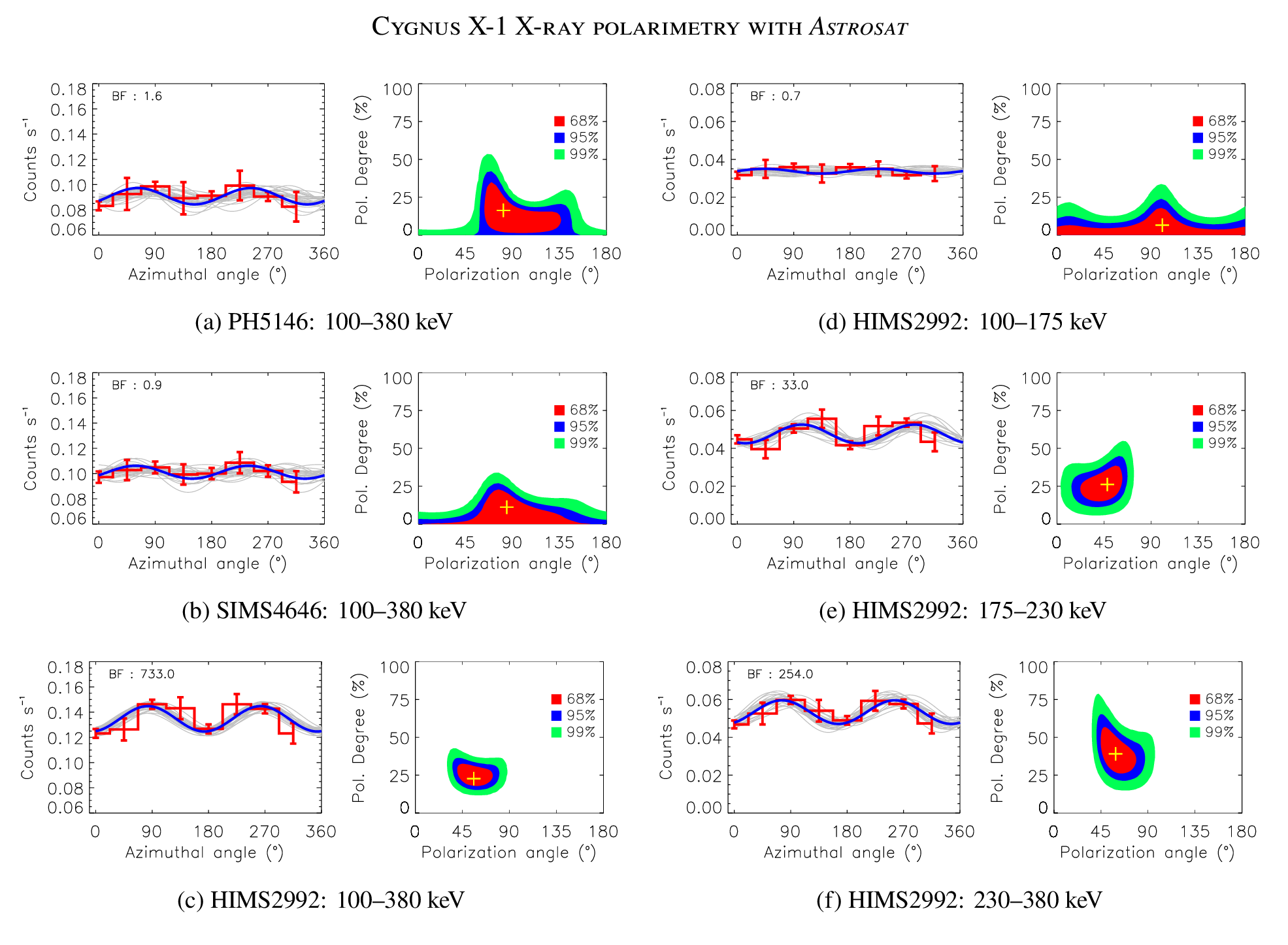AstroSat, India’s first dedicated multi-wavelength Astronomy mission, accomplished the difficult task of measuring the X-ray polarisation of Cygnus X-1 black hole system from data collected over the last 8 years of operation. These measurements have been reported in a scientific article published in Astrophysical Journal Letters. With these unique measurements from AstroSat’s CZT Imager, scientists are inching closer to unravelling the mechanism of production of radiation in these sources.
Discovered over four decades ago, Cygnus X-1 is one of the first confirmed black hole systems in our Galaxy (located at a distance of 400 million times the Sun-Earth distance). The black hole in Cygnus X-1 is twenty times heavier than the Sun, and has a companion - a heavy supergiant star (forty times more massive than the Sun) in a binary system. Due to the gravitational pull of the black hole, material from the supergiant falls and spirals-in towards the black hole. This process leads to the formation of a thin accretion disk which is responsible for soft X-rays. A pair of relativistic jets arranged perpendicular to the disk are thought to arise from the innermost regions, these jets are responsible for the radio emission. Due to its brightness and proximity to the Earth, this enigmatic source has been observed extensively around the world at all electromagnetic wavelengths. Black hole X-ray binaries including Cygnus X-1 are known to exhibit multiple accretion regimes of which two extremes are the soft state with the dominant emission from a thin accretion disk and the hard state in which copious high energy X-rays are produced by mechanisms that are yet to be fully understood - the most promising model being emission from a hot plasma cloud, called a corona, near the black hole. These sources flit between the accretion regimes in months-years timescales, passing through various intermediate states. A particularly interesting state is the hard intermediate state where many of these sources also exhibit radio emission from a narrow relativistic jet. Does this jet also contribute to the observed hard X-ray emission? The answer to this could lead to a significant improvement in our understanding of the jet formation, energetics, magnetic field strength and geometry, as well as the intricate interplay between the corona and the jet. To arrive at the answer, however, one needs to measure the polarisation of the X-ray emission.
Measuring X-ray polarisation is difficult, as the methods are complex and the detected photons are often too few in number to yield reliable estimates. In the six decades since the birth of X-ray astronomy, there have only been 3 or 4 reports on X-ray polarisation measurements of Cygnus X-1. In the paper published on December 29, 2023 in the Astrophysical Journal Letters, Indian scientists using data from AstroSat’s Cadmium Zinc Telluride Imager (CZTI), reported around 24% polarised high energy X-rays with a very high detection significance. These results hint that the mechanism of X-ray emission more energetic than 200 keV is from the jet, possibly synchrotron radiation in an ordered magnetic field. The polarisation of X-rays from the Corona, due to the scattering of local thermal radiation, is expected to be less than 10%. Moreover, the CZT imager detected high X-ray polarisation only in the state that exhibits strong radio emission from the jet. For the first time, therefore, one can confirm the direct connection of the hard X-ray emission to the relativistic jet. According to Prof. A. R. Rao from the Tata Institute of Fundamental Research (TIFR) and PI of the CZTI payload, “X-ray polarisation measurements are critical for astrophysics, and CZTI is uniquely capable of measuring polarisation in this energy range. These results will be used by theoretical astrophysicists around the world for their theories for years to come.”
Measuring X-ray polarisation is difficult, as the methods are complex and the detected photons are often too few in number to yield reliable estimates. In the six decades since the birth of X-ray astronomy, there have only been 3 or 4 reports on X-ray polarisation measurements of Cygnus X-1. In the paper published on December 29, 2023 in the Astrophysical Journal Letters, Indian scientists using data from AstroSat’s Cadmium Zinc Telluride Imager (CZTI), reported around 24% polarised high energy X-rays with a very high detection significance. These results hint that the mechanism of X-ray emission more energetic than 200 keV is from the jet, possibly synchrotron radiation in an ordered magnetic field. The polarisation of X-rays from the Corona, due to the scattering of local thermal radiation, is expected to be less than 10%. Moreover, the CZT imager detected high X-ray polarisation only in the state that exhibits strong radio emission from the jet. For the first time, therefore, one can confirm the direct connection of the hard X-ray emission to the relativistic jet. According to Prof. A. R. Rao from the Tata Institute of Fundamental Research (TIFR) and PI of the CZTI payload, “X-ray polarisation measurements are critical for astrophysics, and CZTI is uniquely capable of measuring polarisation in this energy range. These results will be used by theoretical astrophysicists around the world for their theories for years to come.”

Figure: The modulation in source count rate due to X-ray polarisation. Measurements of X-ray polarisation in different energy bands and the state of the source (PH: Pure Hard, HIMS: Hard Intermediate, SIMS: Soft Intermediate) are shown in the figure. The polarisation fraction and the polarisation angle, are depicted by ‘+’ sign in yellow colour in each contour plot.
The Cadmium Zinc Telluride Imager (CZTI) instrument on board AstroSat consists of a large number of small size pixels (around sixteen thousands in number), each of which is working as an independent detector. A high energy X-ray photon striking such a detector generates a small electric signal that helps measure the energy of the photon. An incident X-ray photon sometimes undergoes “Compton scattering”, that produces a signal in two neighbouring pixels. These pixel pairs tend to align preferably in the direction perpendicular to the polarisation vector of the incident radiation. The CZTI was built to enable the measurement of this effect after extensive tests on the ground before launch. In a massive ground-calibration effort, each of the sixteen thousand pixels of CZTI was calibrated with utmost detail before the launch of the satellite. A sophisticated firmware developed by the team at Vikram Sarabhai Space Centre, Thiruvananthapuram played a key role in recording the polarisation signal on board.
Despite all these preparations, the measurements did not come easy. The challenge was that Cygnus X-1, despite being one of the brightest X-ray ray sources in the sky, provides rather few hard X-ray photons. The cosmic X-ray background is everywhere, so to measure the polarisation of the actual source photons, It is important to identify and subtract the actual X-ray background. Several months were therefore spent in ensuring the reliability of the results. In the process, novel analysis techniques and statistical tests were developed. Nearly one million seconds of observation were carried out from AstroSat for this source under the special AstroSat proposal scheme known as AstroSat long term key proposals (ALTKP). This was a vast collaborative effort across many academic institutes. The lead author of the paper, Dr. Tanmoy Chattopadhyay, who works at Stanford University, said “We have worked hard on this for a decade - starting with my PhD thesis before the launch of AstroSat. It is very fulfilling to get these wonderful results following all the effort”.
With more data already available and to be proposed in future, CZTI will provide many more such measurements and build an invaluable resource for the study of black hole emission. It is important to understand the source emission mechanism and geometry in a broad energy range to get the complete picture of the source which would help to understand the black hole binaries in general. In future, coordinated observations in broad band energy with the existing facilities like IXPE and the newly launched Indian observatory XPOSAT together with AstroSat would give a wealth of information about such objects. According to Prof. Gulab Dewangan from IUCAA, “The Indian research community is growing stronger in the field of X-ray polarisation, and the use of an existing instrument for this measurement is a testimony to the ingenuity of our researchers. These results and experience will be useful when data from XPoSat is available.”
Despite all these preparations, the measurements did not come easy. The challenge was that Cygnus X-1, despite being one of the brightest X-ray ray sources in the sky, provides rather few hard X-ray photons. The cosmic X-ray background is everywhere, so to measure the polarisation of the actual source photons, It is important to identify and subtract the actual X-ray background. Several months were therefore spent in ensuring the reliability of the results. In the process, novel analysis techniques and statistical tests were developed. Nearly one million seconds of observation were carried out from AstroSat for this source under the special AstroSat proposal scheme known as AstroSat long term key proposals (ALTKP). This was a vast collaborative effort across many academic institutes. The lead author of the paper, Dr. Tanmoy Chattopadhyay, who works at Stanford University, said “We have worked hard on this for a decade - starting with my PhD thesis before the launch of AstroSat. It is very fulfilling to get these wonderful results following all the effort”.
With more data already available and to be proposed in future, CZTI will provide many more such measurements and build an invaluable resource for the study of black hole emission. It is important to understand the source emission mechanism and geometry in a broad energy range to get the complete picture of the source which would help to understand the black hole binaries in general. In future, coordinated observations in broad band energy with the existing facilities like IXPE and the newly launched Indian observatory XPOSAT together with AstroSat would give a wealth of information about such objects. According to Prof. Gulab Dewangan from IUCAA, “The Indian research community is growing stronger in the field of X-ray polarisation, and the use of an existing instrument for this measurement is a testimony to the ingenuity of our researchers. These results and experience will be useful when data from XPoSat is available.”
CZT-Imager is built by a consortium of Institutes across India. The Tata Institute of Fundamental Research, Mumbai, led the effort with instrument design and development. Vikram Sarabhai Space Centre, Thiruvananthapuram provided the electronic design, assembly and testing. U R Rao Satellite Center (URSC, formerly ISAC), Bengaluru provided the mechanical design, quality consultation and project management. The Inter University Centre for Astronomy and Astrophysics (IUCAA), Pune did the Coded Mask design, instrument calibration, and operates the Payload Operation Centre. The Space Application Centre (SAC) at Ahmedabad provided the analysis software. Physical Research Laboratory (PRL) Ahmedabad, provided the polarisation detection algorithm and ground calibration. A vast number of industries participated in the fabrication and the University sector pitched in by participating in the test and evaluation of the payload. The Indian Space Research Organisation funded, managed and facilitated the project.
Article:
“High hard X-ray polarisation in Cygnus X-1 confined to the intermediate hard state: evidence for a variable jet componen”Tanmoy Chattopadhyay, Abhay Kumar, A. R. Rao, Yash Bhargava, Santosh V. Vadawale, Ajay Ratheesh, Gulab Dewangan, Dipankar Bhattacharya, N. P. S. Mithun, and Varun Bhalerao
The Astrophysical Journal Letters, 960, L2, 2024 [ DOI: 10.3847/2041-8213/ad118d ]
Find the Hindi translation of the above text here: Click Here
Research contacts:
 |
Mr. Tanmoy Chattopadhyay Stanford University, USA E-mail: tanmoyrng1_at_gmail.com Phone: +18148529733 |
 |
Prof. Gulab Dewangan IUCAA, Pune E-mail: gulabd_at_iucaa.in Phone: +91-20-25604412 |
 |
Dr. Varun Bhalerao IITB, Mumbai E-mail: varunb_aat_iitb.ac.in Phone: +91-22-2576937 |
